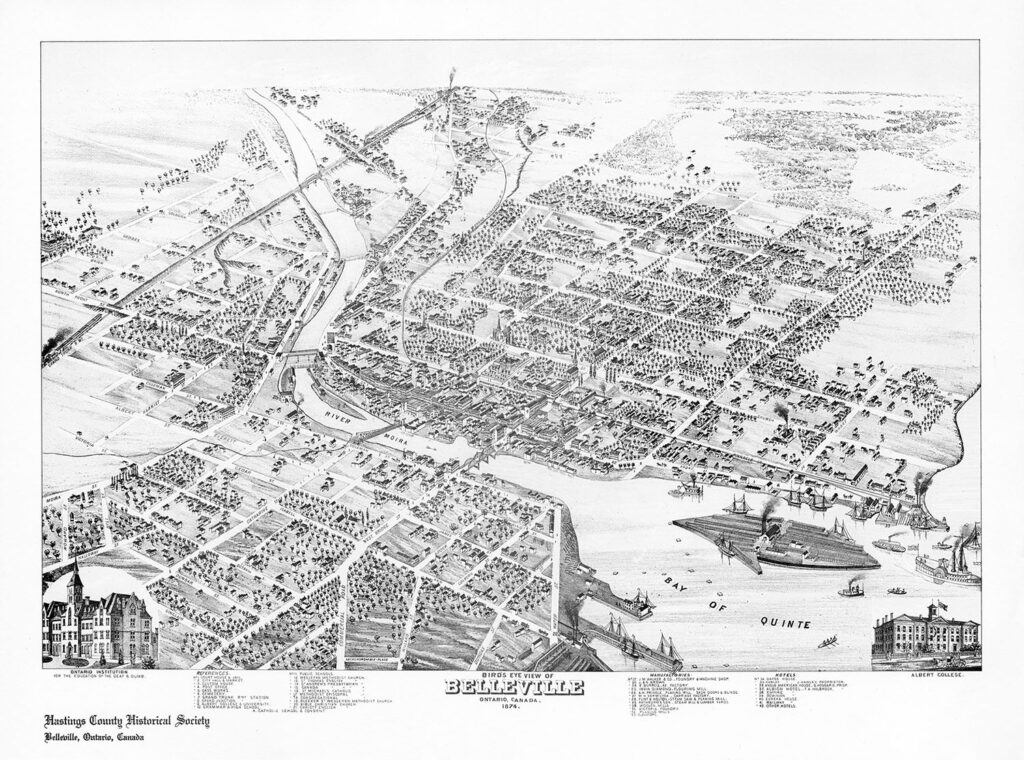Belleville is a city located on the north shore of the Bay of Quinte in southeastern Ontario, Canada. It has a population of approximately 50,000 and serves as the county seat of Hastings County.
Belleville in the 1800’s
Belleville was founded in 1816 by United Empire Loyalists and named after the wife of one of its early settlers, Justus McCord Sills. It was strategically situated at the mouth of the Moira River where it empties into the Bay of Quinte, providing access to transportation routes on both waterways. This allowed Belleville to develop as an important industrial and trading centre in the early 19th century. Lumber, grain, and other goods were shipped via the Bay of Quinte and Moira River.
By the 1850s, Belleville had become a major manufacturing hub. Industries that developed included flour milling, woolen mills, foundries, and carriage works. The opening of the Grand Trunk Railway in 1856, with a station in Belleville, provided crucial freight and passenger connections, further boosting the city’s economy. This period saw Belleville’s population grow rapidly, reaching over 6,000 residents by 1861.

Belleville in the 1900’s – 2000’s
In the late 19th and early 20th centuries, Belleville continued to prosper as an industrial centre. Key employers included Zwick’s Island Industries, which produced farm equipment, and the Bell Organ and Piano factory. The Moira River provided hydroelectric power to factories. Belleville also became known for its brick manufacturing industry during this time. By 1911, the population had grown to over 12,000 people.
After World War II, Belleville saw changes to its economic base as older industries declined. The city transitioned to a service-oriented economy focused on healthcare, retail, and education. Major employers now include Quinte Health Care, which operates Belleville General Hospital, as well as Loyalist College and grocery chain Metro Inc. Tourism has also become important to the local economy thanks to attractions like Tyendinaga Cavern and Caves.
Belleville’s cultural heritage is reflected in architectural landmarks like Glanmore National Historic Site, a restored Victorian mansion. The downtown contains many historic buildings and is home to the Bell Homestead Museum. The city hosts numerous annual events such as Ribfest and the Santa Claus parade.
While no longer a major industrial centre, Belleville remains a regional hub for the surrounding communities in Hastings County. It offers urban amenities within a setting that maintains ties to the area’s natural beauty along the Bay of Quinte. This balanced quality of life has allowed the city to retain and attract residents as it transitions to a modern economy.
Belleville Council & Governance
Belleville is governed by a city council consisting of a mayor and six city councillors. Notable mayors in the city’s history include William Johnson (1867-1869), who helped establish many of Belleville’s institutions during a period of growth, and Neil Ellis (2006-2014), who spearheaded downtown revitalization efforts.
Belleville has a humid continental climate with warm summers and cold, snowy winters. Average yearly precipitation is around 900mm. The Moira River flows through the city and remains an important natural feature. Other bodies of water include Zwick’s Island and the Bay of Quinte to the east.
Education has always played a key role in Belleville. The city is home to Loyalist College, which opened in 1967 and now has around 5,000 full-time students. It offers programs in business, health sciences, skilled trades and more. Elementary and secondary schools are run by the Hastings and Prince Edward District School Board.
The arts scene has grown significantly in recent decades. Major cultural venues include the Bell Park Centre performing arts theatre and the Belleville Art Gallery. An active downtown makes the city a destination for dining, shopping and nightlife. The historic Cannifton neighbourhood southwest of downtown also contains many well-preserved late 19th century homes.
